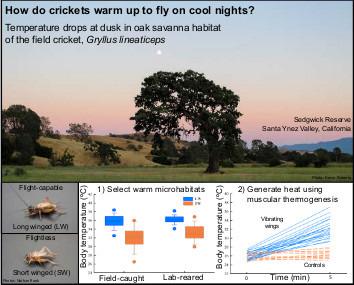当前位置:
X-MOL 学术
›
Funct. Ecol.
›
论文详情
Our official English website, www.x-mol.net, welcomes your feedback! (Note: you will need to create a separate account there.)
Nocturnal dispersal flight of crickets: Behavioural and physiological responses to cool environmental temperatures
Functional Ecology ( IF 5.2 ) Pub Date : 2020-07-14 , DOI: 10.1111/1365-2435.13615 Bao‐Jun Sun 1, 2 , Christopher Huebner 2 , Lisa A. Treidel 2 , Rebecca M. Clark 2, 3 , Kevin T. Roberts 2 , G. J. Kenagy 4 , Caroline M. Williams 2
中文翻译:

c的夜间分散飞行:对凉爽环境温度的行为和生理反应
更新日期:2020-07-14
Functional Ecology ( IF 5.2 ) Pub Date : 2020-07-14 , DOI: 10.1111/1365-2435.13615 Bao‐Jun Sun 1, 2 , Christopher Huebner 2 , Lisa A. Treidel 2 , Rebecca M. Clark 2, 3 , Kevin T. Roberts 2 , G. J. Kenagy 4 , Caroline M. Williams 2
Affiliation

|
- Flight of nocturnal insects may be limited by cool nighttime environmental temperatures. We used laboratory and field experiments to explore the thermal basis of nocturnal flight in wing‐polymorphic Gryllus lineaticeps crickets consisting of long‐winged (LW), flight‐capable morphs and short‐winged (SW), flight‐incapable morphs. These crickets are a model for life history evolution and loss of flight, but their thermal requirements for flight have been unknown. We hypothesized that LW crickets achieve warm body temperatures required for flight through a combination of behavioural thermoregulation, producing heat endogenously (either by initiating muscular thermogenesis or increasing resting metabolic rate) and minimizing heat loss (by circulatory adjustments or insulation).
- Summer evening air temperatures in the field gradually declined from 25 to 18°C during the hours of nighttime cricket activity. Laboratory LW crickets did not fly at a body temperature of 18°C, and 60% flew at 25°C. In an experimental thermal gradient, spontaneous flight did not occur until body temperature exceeded 35°C, confirming that nocturnal field air temperature limits flight in this species.
- In a thermal gradient, LW crickets preferred higher temperatures (~36°C) than SW crickets (~32.5°C). In the field, all crickets were warmer than air temperature but considerably cooler than their preferred temperatures. LW crickets had higher field body temperatures (24.3°C) than SW crickets (22.3°C). LW crickets spontaneously initiated muscular thermogenesis through wing vibrations, increasing body temperature to a pre‐flight maximum of 35°C. Muscular thermogenesis was limited below 25°C. LW crickets cooled more slowly and had higher metabolic rates than SW crickets.
- We conclude that LW crickets prepare to fly on cool nights by gaining heat from warm substrates, activating endogenous muscular thermogenesis and reducing their cooling rate. These mechanisms are absent or less pronounced in SW crickets. The overall thermoregulatory strategy we report represents a previously unrecognized component of insect dispersal polymorphism. We suggest that thermal constraints on nocturnal flight may have contributed to evolutionary loss of flight in other insect groups.
中文翻译:

c的夜间分散飞行:对凉爽环境温度的行为和生理反应
- 夜间昆虫的飞行可能受凉爽的夜间环境温度的限制。我们使用实验室和野外实验研究了由长翼(LW),具有飞行能力的变体和短翅(SW)和无飞行能力的变体组成的机翼多形Gryllus lineaticeps的夜间飞行的热学基础。这些是生活史演变和飞行损失的模型,但对飞行的热学要求尚不清楚。我们假设LW s通过行为温度调节,通过内源性产生热量(通过引发肌肉生热或增加静息代谢率)和使热量损失最小(通过循环调节或隔离)达到飞行所需的温暖体温。
- 在夜间板球活动期间,田间夏季傍晚的气温从25摄氏度逐渐降低至18摄氏度。实验室LW在18°C的体温下不会飞行,在25°C时可飞60%。在实验热梯度中,直到体温超过35°C才发生自发飞行,这证实了夜间野外气温限制了该物种的飞行。
- 在热梯度下,LW preferred的温度(〜36°C)比SW((〜32.5°C)高。在野外,所有的温度都比气温高,但比首选温度要低得多。LW的田间体温(24.3°C)比SW(22.3°C)高。LW cket通过机翼振动自发地引发肌肉生热,使体温升高到飞行前最高35°C。肌肉生热仅限于25°C以下。LW cooled的冷却速度比SW s慢,并且代谢率更高。
- 我们得出的结论是,W在温暖的底物上获取热量,激活内源性肌肉生热并降低其冷却速度,从而在寒冷的夜晚准备飞翔。这些机制在西南中不存在或不太明显。我们报告的总体体温调节策略代表昆虫扩散多态性以前无法识别的成分。我们建议夜间飞行的热约束可能是导致其他昆虫群体中飞行的进化损失的原因。


























 京公网安备 11010802027423号
京公网安备 11010802027423号